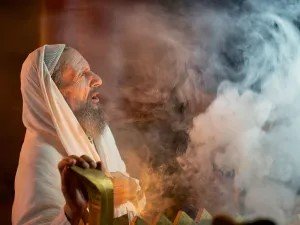Over the net four Sundays, we’re going to be doing something different during the sermon time. We are going to be practicing different types of prayers together. As I mentioned last week, over the years of my ministry, many of the questions that parishioners have asked me have had to do with prayer: how to pray, what to pray, what to pray for. And I have tried to help people find ways to pray that make sense to them, that feel right and comfortable.
But about nine years ago, I learned about the work of Patricia D. Brown, who wrote about different prayer styles based on our personalities. She wrote a book, Paths to Prayer: Finding Your Own Way to the Presence of God, and in it she included a self-assessment tool and a description of four different styles of prayer. Most people will score higher in one style than the others, and that style is the one that they are likely to feel most comfortable with. The four styles are Searching Prayer, Experiential Prayer, Relational Prayer, and Innovative Prayer. Taking the self-assessment and discovering your prayer style is really just the beginning. For one thing, there are lots of variables that will influence your prayer life besides your personality: your family, education, geography, culture, experiences, living situation, mental state, skills, and abilities all play a part. You may not like all the prayer types in your category, and you may feel more comfortable using prayers that are not in your category. But at least the assessment tool gives you an idea of where you might start.
This morning, we’re going to focus on the Searching Prayer Style. If your score was high in column 1 of the assessment tool, you are likely to be inclined towards this type of prayer. How many of you scored highest in the Searching Prayer Style? See if this describes you: You lean on your knowledge and your intellectual skills to help you in your spiritual life. Spiritual insights are likely to come to you through observation, study, and even debate. As you learn and experience new prayer practices, you will want to evaluate them logically to see whether or not they fit with your beliefs. You have an appreciation for clear teachings and wisdom that can be applied to concrete life circumstances. Accountability and fairness are important to you; so are structure and order. You have a logical mind, you value telling the truth, you tend to have a linear viewpoint, you have clear convictions, a humble spirit, and a discerning spirit, as well as a true thirst for God.
There are a number of prayer practices that may feel comfortable for those who have a Searching Prayer Style. One of the prayers that you might pray frequently is the Lord’s Prayer. Other practices include praying the scriptures; something called lectio divina; keeping a prayer journal; making a pilgrimage; and praying with icons. I want to describe all of these practices, and then we’re going to try two of them.
First, praying with icons. Many people have trouble keeping their eyes closed when they pray. Your thoughts race from one thing to another and you just feel distracted. Paying attention to an icon can be a way to overcome those distractions. Icons invite us to pray with our eyes open, focusing our attention on an image that points the way to God. Icons move beyond words to help connect us to God through a visual reminder. The first icon, and one shared by every branch of the Christian faith, is the cross. Icons have been a part of Christian tradition from at least the 4th century. Protestants have, for the most part, not made use of icons until recent years. But they have always been part of prayer in the Orthodox Church. I have placed another icon on the altar, this egg-shaped icon with a picture of Christ on it. I purchased it a number of years ago and sometimes use it in my prayer time.
Second, there is the practice of using a prayer journal. Putting your thoughts down on paper when you pray can help you be more objective about what you’re feeling and thinking. Then you can open your mind and your heart to listen to what God may be trying to say to you. Writing in a journal can help you sort out where you are before you actually share your thoughts with God. You can include scripture readings, quotes that have meaning to you, and insights about things you did or said during the day. Writing about your life’s challenges can help you get clarity in your relationships with God, with others, and with yourself. As you re-read the things you write in your journal, you start to see the choices you have made and how you have changed over the course of your life. You can see evidence of how God has been at work in your life, as well as times when you have chosen not to let God act. There are several ways you can get started in a prayer journal if it is a new practice to you. You can simply write a letter to God. Tell God what you are thinking and feeling, or what you need. You can also try writing a letter from God to you; imagine what God might want to say to you.
Third, you can make a pilgrimage. That is a lot more involved than the other practices I’ve talked about so far. But a pilgrimage to a sacred site can have an impact on our lives for years to come. Two popular pilgrimage sites are Rome and the Holy Land. Santiago de Compostela, in northwestern Spain, is the most famous medieval pilgrimage site and is the culmination of the Camino de Santiago pilgrimage route. The remains of St. James, the apostle, were believed to have been brought to Spain from the Holy Land during the 9th century and lie within the Cathedral in that city. I know several pastors from New England who have walked that pilgrimage route, which takes several days. Some places you might travel in the United States include the National Cathedral in Washington, D.C.; the monastery home of Thomas Merton in Gethsemane, Kentucky; or the mission churches of the Southwest. I have been to the Mission San Juan Capistrano in California, and several missions in the San Antonio area in Texas. Closer to home, you might simply go to the grave of a family member or loved one; a retreat center; or a church you’ve never been to before. If you could take a pilgrimage anywhere in the world, where would you go?
Okay, now we’re going to try a couple of prayer practices that may be new to you. First, we’re going to try praying the scriptures. When we read the Bible, it is important to remember that we are reading the Word of God. When we listen with our hearts as well as our heads, scripture touches us and moves us to live in God’s will in a greater way than we have before. Madame Guyon, a woman of faith who lived in France from 1648 to 1717, wrote, “’Praying the Scripture’ is not judged by how much you read but by the way you read. If you read quickly, it will benefit you little. You will be like a bee that merely skims the surface of a flower. Instead, in this new way of reading with prayer, you become as the bee who penetrates into the depths of the flower. You plunge deeply within to remove its deepest nectar.”
Praying the scriptures is more than just reading the scriptures. There are 4 R’s involved: reading, reflecting, responding, and resting. It is important to move slowly from verse to verse, and from idea to idea, not just reading through the entire passage at once. You take time to make note of verses or even phrases that speak to you in some way. You should only read 10 verses or lines at a time; more than that will be overwhelming. Passages from the Psalms or the Gospels tend to be good ones to use. You will need your pen and paper for this type of prayer.
First, read the passage slowly.
They came to Bethsaida, and some people brought a blind man and begged Jesus to touch him. He took the blind man by the hand and led him outside the village. When he had spit on the man’s eyes and put his hands on him, Jesus asked, “Do you see anything?”
He looked up and said, “I see people; they look like trees walking around.”
Once more Jesus put his hands on the man’s eyes. Then his eyes were opened, his sight was restored, and he saw everything clearly. Jesus sent him home, saying, “Don’t even go into the village.”
Now, meditate for one minute on what you just read.
Read the passage again.
They came to Bethsaida, and some people brought a blind man and begged Jesus to touch him. He took the blind man by the hand and led him outside the village. When he had spit on the man’s eyes and put his hands on him, Jesus asked, “Do you see anything?”
He looked up and said, “I see people; they look like trees walking around.”
Once more Jesus put his hands on the man’s eyes. Then his eyes were opened, his sight was restored, and he saw everything clearly. Jesus sent him home, saying, “Don’t even go into the village.”
Take another moment to think about the passage.
Now copy on a piece of paper the verse or phrase that touched your heart.
Write your response. You can write the response as a simple prayer.
That wasn’t so hard, was it?
Now, the final practice is what is known as lectio divina, or holy reading. The Bible is the main resource for this type of prayer, but you can also use other writings, such as the Apostles Creed or the writings of other Christians through the centuries. The practice became popular in the 4th and 5th centuries, when books were scarce and expensive. One person could read a passage out loud for all those who had gathered together. It would be read more than once, so that people could absorb it, or even memorize it. The practice was also common in the 9th century Benedictine community life. Guigo II, a medieval Christian leader, systematized the process into four stages: lectio, which is the reading aloud of the text; meditatio, which is meditation, or reflection, on the text; oratio, or affective prayer, when the will moved spontaneously in response to the reflection; and contemplatio, or contemplation, when you move into a state of resting in the presence of God.
So, let’s give it a try:
Lectio: Read Psalm 42
As the deer pants for streams of water,
so my soul pants for you, my God.
My soul thirsts for God, for the living God.
When can I go and meet with God?
My tears have been my food
day and night,
while people say to me all day long,
“Where is your God?”
These things I remember
as I pour out my soul:
how I used to go to the house of God
under the protection of the Mighty One[d]
with shouts of joy and praise
among the festive throng.
Why, my soul, are you downcast?
Why so disturbed within me?
Put your hope in God,
for I will yet praise him,
my Savior and my God.
My soul is downcast within me;
therefore I will remember you
from the land of the Jordan,
the heights of Hermon—from Mount Mizar.
Deep calls to deep
in the roar of your waterfalls;
all your waves and breakers
have swept over me.
By day the Lord directs his love,
at night his song is with me—
a prayer to the God of my life.
I say to God my Rock,
“Why have you forgotten me?
Why must I go about mourning,
oppressed by the enemy?”
My bones suffer mortal agony
as my foes taunt me,
saying to me all day long,
“Where is your God?”
Why, my soul, are you downcast?
Why so disturbed within me?
Put your hope in God,
for I will yet praise him,
my Savior and my God.
Meditatio: Identify a word, phrase, sentence, or idea that most caught your attention, and reflect on it. Normally, allow five minutes or longer for this.
Lectio: Read the passage again.
Meditatio: Where does this passage touch your life, your community, your nation, or the world today? Reflect for five minutes or longer.
Lectio: Read the passage a third time.
Contemplatio: From the passage and your reflections, what does God want you to do or be? How does God invite you to change? Take five minutes or longer to con-template. What message is God sending you?
Oratio: Lectio divina is reading that leads to prayer. It begins as God addressing us, through the reading, and our response to it; then it leads us into the presence of God, into union with the divine will. Our hearts and minds move toward God, and this movement of the heart is the beginning of prayer. Continue to pray as you feel led for as long as you wish.
St. John of the Cross, an ordained pastor and mystic who lived in Spain from 1542 to 1591, wrote, “Seek in reading and you will find in meditation; knock in prayer and it will be opened to you in contemplation.” I hope that the practice of lectio divina and holy reading today has given you a sampling of the kinds of prayer practices that might be comfortable for those who have a Searching Prayer Style, as well as for the rest of us. I would encourage all of you to try these practices again on your own. Even if they don’t’ feel right or comfortable, they can help you to grow in your own spirituality and your sense of how to pray. And next week, we will continue with the next style, the Experiential Prayer Style.




























